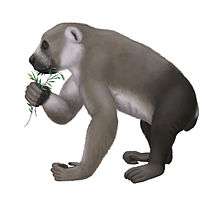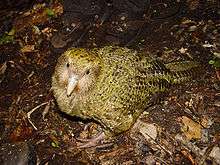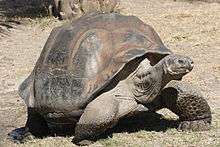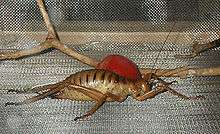Island gigantism


Island gigantism or insular gigantism is a biological phenomenon in which the size of animals isolated on an island increases dramatically in comparison to their mainland relatives. Island gigantism is one aspect of the more general "island rule", which posits that when mainland animals colonize islands, small species tend to evolve larger bodies, and large species tend to evolve smaller bodies. With the arrival of humans and associated predators (dogs, cats, rats, pigs), many giant as well as other island endemics have become extinct.
Possible causes
Large mammalian carnivores are often absent on islands because of insufficient range or difficulties in over-water dispersal. In their absence, the ecological niches for large predators may be occupied by birds, reptiles or smaller carnivorans, which can then grow to larger-than-normal size. For example, on prehistoric Gargano Island in the Miocene-Pliocene Mediterranean, on islands in the Caribbean like Cuba, and on Madagascar and New Zealand, some or all apex predators were birds like eagles, falcons and owls, including some of the largest known examples of these groups. However, birds and reptiles generally make less efficient large predators than advanced carnivorans.
Since small size usually makes it easier for herbivores to escape or hide from predators, the decreased predation pressure on islands can allow them to grow larger.[1][lower-alpha 1] Small herbivores may also benefit from the absence of competition from missing types of large herbivores.

Benefits of large size that have been suggested for island tortoises include decreased vulnerability to scarcity of food and/or water, through ability to survive for longer intervals without them, or ability to travel longer distances to obtain them. Periods of such scarcity may be a greater threat on oceanic islands than on the mainland.[4]
Thus, island gigantism is usually an evolutionary trend resulting from the removal of constraints on the size of small animals related to predation and/or competition.[5] Such constraints can operate differently depending on the size of the animal, however; for example, while small herbivores may escape predation by hiding, large herbivores may deter predators by intimidation. As a result, the complementary phenomenon of island dwarfism can also result from the removal of constraints related to predation and/or competition on the size of large herbivores.[6] In contrast, insular dwarfism among predators more commonly results from the imposition of constraints associated with the limited prey resources available on islands.[6] As opposed to island dwarfism, island gigantism is found in most major vertebrate groups and in invertebrates.
Territorialism may favor the evolution of island gigantism. A study on Anaho Island in Nevada determined that reptile species that were territorial tended to be larger on the island compared to the mainland, particularly in the smaller species. In territorial species, larger size makes individuals better able to compete to defend their territory. This gives additional impetus to evolution toward larger size in an insular population.[7]
A further means of establishing island gigantism may be a founder effect operative when larger members of a mainland population are superior in their ability to colonize islands.[8]
Island size plays a role in determining the extent of gigantism. Smaller islands generally accelerate the rate of evolution of changes in organism size, and organisms there evolve greater extremes in size.[9]
Examples
Examples of island gigantism include:
Mammals

Many rodents grow larger on islands, whereas carnivores, proboscideans and artiodactyls usually become smaller.
- Soricomorphs
- Mediterranean giant shrews - Asoriculus (extinct)
- Corsican giant shrew - Asoriculus corsicanus, Corsica (extinct)
- Sardinian shrew - Asoriculus similis, Sardinia (extinct)
- Balearic giant shrew - Asoriculus hidalgo, Majorca and Minorca (extinct)
- Solenodon
- Giant solenodon - Solenodon arredondoi, Cuba (extinct)
- Cuban solenodon - Solenodon cubanus, Cuba
- Hispaniolan solenodon - Solenodon paradoxus, Hispaniola
- Mediterranean giant shrews - Asoriculus (extinct)
- Erinaceomorphs
- Deinogalerix - Gargano Island (extinct)
- Rodents
- Flores giant rat - Papagomys armandvillei, Flores
- Sulawesi giant rat - Paruromys dominator, Sulawesi
- Canary Islands giant rats - Canariomys (extinct)
- Gran Canaria giant rat - Canariomys tamarani; Gran Canaria, Canary Islands (extinct)
- Tenerife giant rat - Canariomys bravoi; Tenerife, Canary Islands (extinct)
- Giant hutias of the West Indies (extinct)
- Balearic giant dormice - Hypnomys (extinct)
- Majorcan giant dormouse - Hypnomys morpheus, Majorca (extinct)
- Minorcan giant dormouse - Hypnomys mahonensis, Minorca (extinct)
- Sicilian giant dormice - Leithia (extinct)
- Formentera black-tailed garden dormouse - Eliomys quercinus ophiusae, Formentera, Balearic islands (descendant of garden dormice introduced from the continent by Neolithic humans)
- St Kilda field mouse - Apodemus sylvaticus hirtensis, St Kilda (descendant of wood mice introduced by humans)
- Lagomorphs
- Minorcan giant lagomorph - Nuralagus rex (extinct)
- Different Prolagus Mediterranean species, including the extinct Sardinian pika (P. sardus) and P. imperialis from Gargano
- Primates
- Giant lemurs Archaeoindris, Palaeopropithecus and Megaladapis of Madagascar (all extinct)
- Carnivorans
- Sardinian giant otter - Megalenhydris barbaricina (extinct)
- Madagascar's fossa, Cryptoprocta ferox and the extinct giant fossa Cryptoprocta spelaea, carnivorans related to herpestids (and convergent in appearance with cougars)[lower-alpha 2]
- Chapalmalania, an extinct bear-sized procyonid that lived in South America before the formation of the isthmus of Panama, whose smaller ancestors dispersed there from Central America[lower-alpha 3]
Birds

- Ratites
- The elephant bird, among the largest birds ever, formerly living on Madagascar (extinct).
- The extinct moa of New Zealand.
- Waterfowl
- Moa-nalo, extinct giant ducks from Hawaii.
- The extinct giant swan Cygnus falconeri of Sicily and Malta
- Wildfowl
- Sylviornis neocaledoniae a huge extinct megapode-like bird from New Caledonia
- Some extinct Polynesian megapodes.
- Rails
- Seabirds
- The extinct spectacled cormorant from Bering Island.
- Pigeons
- Dodo and Rodrigues solitaire, both extinct, from the Mascarenes
- The extinct flightless Viti Levu giant pigeon.
- Birds of prey
- Haast's eagle and Eyles' harrier of New Zealand; the titan-hawk Titanohierax and giant-hawk Gigantohierax from the Caribbean; the giant buteonine hawk Buteogallus borrasi of Cuba (all now extinct).[10]
- Parrots
- The extinct broad-billed parrot from Mauritius, an undescribed huge extinct parrot from Easter Island, and the critically endangered kakapo of New Zealand.

- Owls
- The Cuban giant flightless owl Ornimegalonyx, the possibly flightless Cretan owl, and several Tyto barn owls from the Mediterranean (Tyto robusta, Tyto gigantea), Caribbean (Tyto pollens) and Melanesia (all of them extinct).[10]
- Storks
- The Flores flightless stork, Leptoptilos robustus, a very large extinct stork from Flores.[11]
Reptiles
- Turtles
- Giant tortoises in the Galápagos Islands, Seychelles, and formerly the Mascarenes and Canary Islands are often considered examples of island gigantism. However, during the Pleistocene, comparably sized or larger tortoises were present in Australia (Meiolania), southern Asia (Colossochelys atlas), Madagascar (Dipsochelys) and North[12] and South America,[13] as well as on a number of other, more accessible islands.[12] In the late Pliocene they were also present in Africa.[14] The present situation of large tortoises being only found on remote islands may reflect that these islands were discovered by humans fairly recently and have not been heavily populated, making their tortoises less subject to overexploitation.

- Lizards
- The Komodo dragon and a similar (extinct) giant monitor lizard from Timor are examples of giant insular carnivores. Since islands tend to offer limited food and territory, their mammalian carnivores (if present) are usually smaller than continental ones. These cases involve ectothermic carnivores on islands too small to support much mammalian competition. However, these lizards are not as large as their extinct Australian relative Megalania, and it has been proposed based on fossil evidence that the ancestors of these varanids first evolved their large size in Australia and then dispersed to Indonesia.[15] If this is true, rather than being insular giants they would be viewed as examples of phyletic gigantism. Nevertheless, given that Australia is sometimes viewed as the world's largest island, the former view may not be entirely invalid.
- The Angel Island chuckwalla (Sauromalus hispidus) and the San Esteban chuckwalla (Sauromalus varius) of islands off Baja California
- The extinct iguanas Lapitiguana (1.5 m long) from Fiji[16] and Brachylophus gibbonsi (1.2 m) from Tonga[17]
- Leiolopisma mauritiana and Macroscincus coctei, two extinct skinks from Mauritius and Cape Verde, the Solomon Islands skink and the rare New Caledonian skink Phoboscincus bocourti
- The extinct Rodrigues giant day gecko and New Zealand giant gecko, and the extant New Caledonian giant gecko
- Four extant and one extinct species of lacertid lizard of the genus Gallotia in the Canary Islands[18]
- Snakes
- Tiger snake populations on Mount Chappell Island (Tasmania) and Williams Island, Hopkins Island and islands of the Nuyts Archipelago (South Australia).[19] On these islands the available prey is restricted to larger sizes than commonly taken by mainland snakes; restricted seasonal availability of prey also appears to contribute to gigantism.[19]
Arthropods
- Conant's giant Nihoa tree cricket
- Garypus titanius, a pseudoscorpion of Boatswain Bird Island (off Ascension Island)
- Giant pill-millipedes of Madagascar
- Giant wetas of New Zealand
- Lord Howe Island stick insect[20][21]
- Saint Helena earwig (extinct)
- Taveuni and giant Fijian long-horned beetles of Fiji[22]
Flora
Island plants often also exhibit "insular woodiness".[23]
See also
Notes
- ↑ The reduction in predation on islands often also leads to tamer behavior of island prey species, a trend that has been analyzed in lizards.[2][3]
- ↑ At 10 and 20 kg for the living and extinct forms, respectively, the Malagasy species are larger that the largest extant herpestid, 5 kg Ichneumia albicauda.
- ↑ Strictly speaking, not an example of island gigantism. However, when South America was an isolated island continent lacking native carnivorans, it presented similar (but even greater) growth opportunities to small invading carnivorans.
References
- ↑ Herczeg, G. B.; Gonda, A. L.; Merilä, J. (2009-07-16). "Evolution of Gigantism in Nine-Spined Sticklebacks". Evolution. 63 (12): 3190–3200. doi:10.1111/j.1558-5646.2009.00781.x.
- ↑ Cooper, W. E.; Pyron, R. A.; Garland, T. (2014-01-08). "Island tameness: Living on islands reduces flight initiation distance". Proceedings of the Royal Society B: Biological Sciences. 281 (1777): 20133019. doi:10.1098/rspb.2013.3019.
- ↑ Yong, E. (2014-01-08). "Islands make animals tamer". Nature. doi:10.1038/nature.2014.14462.
- ↑ Jaffe, A. L.; Slater, G. J.; Alfaro, M. E. (2011-01-26). "The evolution of island gigantism and body size variation in tortoises and turtles". Biology Letters. 7 (4): 558–561. doi:10.1098/rsbl.2010.1084. PMID 21270022.
- ↑ Barahona, F.; Evans, S.E.; Mateo, J.A.; Garcia-Marquez, M.; Lopez-Jurado, L.F. (March 2000). "Endemism, Gigantism and Extinction in Island Lizards: The Genus Gallotia on the Canary Islands". Journal of Zoology. 250 (3): 373–388. doi:10.1017/s0952836900003101.
- 1 2 Raia, P.; Meiri, S. (August 2006). "The island rule in large mammals: paleontology meets ecology". Evolution. 60 (8): 1731–1742. doi:10.1111/j.0014-3820.2006.tb00516.x. Retrieved 2011-11-27.
- ↑ Keehn, J. E.; Nieto, N. C.; Tracy, C. R.; Gienger, C. M.; Feldman, C. R. (2013-08-27). "Evolution on a desert island: Body size divergence between the reptiles of Nevada's Anaho Island and the mainland around Pyramid Lake". Journal of Zoology. 291 (4): 269–278. doi:10.1111/jzo.12066.
- ↑ Lomolino, M. V. (2005-09-05). "Body size evolution in insular vertebrates: generality of the island rule". Journal of Biogeography. 32 (10): 1683–1699. doi:10.1111/j.1365-2699.2005.01314.x. Retrieved 2011-11-19.
- ↑ Filin, I.; Ziv, Y. (2004). "New Theory of Insular Evolution: Unifying the Loss of Dispersability and Body-mass Change." (PDF). Evolutionary Ecology Research. 6: 115–124.
- 1 2 Naish, Darren (2008-01-28). "Titan-hawks and other super-raptors". Tetrapod Zoology blog. ScienceBlogs LLC. Retrieved 2011-03-02. External link in
|work=(help) - ↑ Meijer H. J. M.; Due, R. A. (2010-11-04). "A new species of giant marabou stork (Aves: Ciconiiformes) from the Pleistocene of Liang Bua, Flores (Indonesia)". Zoological Journal of the Linnean Society. 160 (4): 707–724. doi:10.1111/j.1096-3642.2010.00616.x.
- 1 2 Hansen, D. M.; Donlan, C. J.; Griffiths, C. J.; Campbell, K. J. (April 2010). "Ecological history and latent conservation potential: large and giant tortoises as a model for taxon substitutions" (PDF). Ecography. Wiley. 33 (2): 272–284. doi:10.1111/j.1600-0587.2010.06305.x. Retrieved 2012-03-02.
- ↑ Cione, A. L.; Tonni, E. P.; Soibelzon, L. (2003). "The Broken Zig-Zag: Late Cenozoic large mammal and tortoise extinction in South America" (PDF). Rev. Mus. Argentino Cienc. Nat., n.s. 5 (1): 1–19. ISSN 1514-5158. Retrieved 2011-02-06.
- ↑ Harrison, T. (2011). "Tortoises (Chelonii, Testudinidae)". Paleontology and Geology of Laetoli: Human Evolution in Context, Vol. 2: Fossil Hominins and the Associated Fauna. Vertebrate Paleobiology and Paleoanthropology. Springer Science+Business Media. pp. 479–503. doi:10.1007/978-90-481-9962-4_17. ISBN 978-90-481-9961-7.
- ↑ Turvey, S T.; Hocknull, S. A.; Piper, P. J.; van den Bergh, G. D.; Due, R. A.; Morwood, M. J.; Kurniawan, I. (2009-09-30). Turvey, Samuel T, ed. "Dragon's Paradise Lost: Palaeobiogeography, Evolution and Extinction of the Largest-Ever Terrestrial Lizards (Varanidae)". PLoS ONE. 4 (9): e7241. doi:10.1371/journal.pone.0007241. PMC 2748693
 . PMID 19789642. Retrieved 2012-02-09.
. PMID 19789642. Retrieved 2012-02-09. - ↑ Pregill, G. K.; Worthy, T. H. (March 2003). "A New Iguanid Lizard (Squamata, Iguanidae) from the Lare Quaternary of Fiji, Southwest Pacific". Herpetologica. The Herpetologists' League. 59 (1): 57–67. doi:10.1655/0018-0831(2003)059[0057:ANILSI]2.0.CO;2. ISSN 0018-0831.
- ↑ Pregill, G. K.; Steadman, D. W. (March 2004). "South Pacific Iguanas: Human Impacts and a New Species". Journal of Herpetology. 38 (1): 15–21. doi:10.1670/73-03A. JSTOR 1566081.
- ↑ Maca-Meyer, N.; Carranza, S.; Rando, J. C.; Arnold, E. N.; Cabrera, V. M. (2003-12-01). "Status and relationships of the extinct giant Canary Island lizard Gallotia goliath (Reptilia: Lacertidae), assessed using ancient mtDNA from its mummified remains" (PDF). Biological Journal of the Linnean Society. Linnean Society of London. 80 (4): 659–670. doi:10.1111/j.1095-8312.2003.00265.x. Retrieved 2010-04-03.
- 1 2 Keogh, J. S.; Scott, I. A. W.; Hayes, C. (January 2005). "Rapid and repeated origin of insular gigantism and dwarfism in Australian tiger snakes". Evolution. 59 (1): 226–233. doi:10.1111/j.0014-3820.2005.tb00909.x.
- ↑ Whitman, D. W.; Vincent, S. (December 2008). "Large size as an antipredator defense in an insect". Journal of Orthoptera Research. 17 (2): 353–371. doi:10.1665/1082-6467-17.2.353.
- ↑ Kleinhenz, P. (2011-06-14). "The Endangered Unknown: Lord Howe Island Stick Insect". blog post. Ecomii. Archived from the original on 2011-06-20. Retrieved 2015-08-01.
- ↑ Keppel, Gunnar; Lowe, Andrew J.; Possingham, Hugh P. (2009). "Changing perspectives on the biogeography of the tropical South Pacific: influences of dispersal, vicariance and extinction". Journal of Biogeography. 36 (6): 1035–1054. doi:10.1111/j.1365-2699.2009.02095.x. ISSN 0305-0270.
- ↑ Bowen, Lizabeth; Vuren, Dirk Van (1997). "Insular Endemic Plants Lack Defenses Against Herbivores". Conservation Biology. 11 (5): 1249–1254. doi:10.1046/j.1523-1739.1997.96368.x. ISSN 0888-8892.
